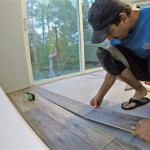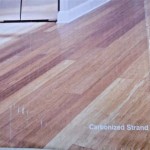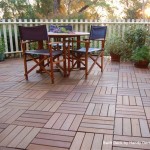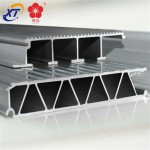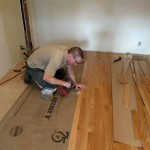Can You Put Wood Flooring Over Underfloor Heating? A Comprehensive Guide
The prospect of warm, inviting wood floors combined with the comfort of underfloor heating is appealing to many homeowners. Understanding the compatibility of these two systems is crucial before embarking on such a project. While wood flooring can indeed be installed over underfloor heating, careful consideration must be given to various factors to ensure optimal performance, efficiency, and longevity of both the heating system and the flooring itself.
Wood, being a natural material, reacts to changes in temperature and humidity. This inherent characteristic necessitates a cautious approach when integrating it with underfloor heating. The goal is to minimize movement, prevent warping or cupping, and maintain the aesthetic appeal of the wood floor while maximizing the heating system's efficiency. Failing to address these concerns can lead to costly repairs and a less than satisfactory outcome.
The type of wood flooring selected, the installation method employed, and the operational parameters of the underfloor heating system all play significant roles in the success of this combination. Thorough research and careful planning are essential to avoid potential pitfalls and ensure a comfortable and durable flooring solution.
Selecting the Right Type of Wood Flooring
Not all wood flooring is created equal when it comes to compatibility with underfloor heating. The stability of the wood species is a primary consideration. Certain wood species are more prone to expansion and contraction than others, making them less suitable for installation over underfloor heating.
Engineered wood flooring is generally the preferred choice over solid wood flooring for this application. Engineered wood consists of a thin layer of hardwood bonded to a core of multiple layers of plywood or other composite materials. This construction provides greater dimensional stability, reducing the risk of warping or cupping when exposed to temperature fluctuations. Solid wood, on the other hand, expands and contracts more significantly, potentially leading to gaps, cracks, or buckling if installed over underfloor heating.
When choosing engineered wood, the thickness of the hardwood veneer and the quality of the core material are also important factors. A thicker veneer will provide a more durable and aesthetically pleasing surface, while a high-quality core will contribute to the overall stability of the flooring. Look for multi-ply cores, as they are generally more stable than single-ply options.
Regarding wood species, those known for their stability include oak, walnut, and maple. These species exhibit less movement in response to temperature and humidity changes compared to more exotic or less dense woods. Softer woods, such as pine or fir, are generally not recommended for use with underfloor heating due to their higher susceptibility to expansion and contraction.
The width and length of the wood planks also affect stability. Narrower planks tend to be more stable than wider planks, as they have less surface area to expand and contract. Similarly, shorter planks are generally preferred over longer planks. Consider the overall design of the room and the desired aesthetic when selecting plank dimensions, but prioritize stability when choosing wood for use with underfloor heating.
Finally, consider the finish applied to the wood flooring. A resistant finish will help protect the wood from moisture and wear, further enhancing its durability and longevity. While pre-finished flooring offers convenience, a site-applied finish allows for greater customization and can be tailored to specific environmental conditions.
Installation Methods and Best Practices
The installation method employed for wood flooring over underfloor heating significantly impacts its performance and longevity. Several installation techniques are commonly used, each with its own advantages and disadvantages.
Floating floors are often recommended for installation over underfloor heating. This method involves installing the flooring over an underlayment without directly adhering it to the subfloor. The underlayment provides a thermal break and helps to distribute heat evenly. Floating floors allow for expansion and contraction of the wood without putting stress on the subfloor.
Direct glue-down installation is another option, but it requires careful selection of adhesive and meticulous adherence to the manufacturer's instructions. The adhesive must be specifically formulated for use with underfloor heating and must be flexible enough to accommodate movement in the wood. The subfloor must be properly prepared to ensure a strong bond with the adhesive.
Nailing or stapling wood flooring directly to a subfloor containing underfloor heating pipes or wires is generally not recommended, as it can puncture the heating system and cause irreversible damage. If nailing or stapling is necessary, extreme caution must be exercised to avoid damaging the heating elements.
Regardless of the installation method chosen, it is crucial to acclimatize the wood flooring to the room's environment before installation. This involves storing the flooring in the room for several days to allow it to adjust to the temperature and humidity levels. This helps to minimize movement after installation.
During installation, leave adequate expansion gaps around the perimeter of the room and around any fixed objects, such as pipes or doorways. These gaps allow the wood flooring to expand and contract without putting pressure on the surrounding structures. The size of the expansion gaps will depend on the type of wood flooring, the room size, and the expected temperature fluctuations.
Use a moisture meter to monitor the moisture content of the wood flooring and the subfloor before, during, and after installation. The moisture content should be within the recommended range for the specific type of wood flooring to prevent problems with expansion and contraction.
Underfloor Heating System Considerations
The type and operational parameters of the underfloor heating system are critical factors in determining its compatibility with wood flooring. Different types of underfloor heating systems have varying heat output and respond differently to changes in temperature.
Both hydronic (water-based) and electric underfloor heating systems can be used with wood flooring, but hydronic systems are generally preferred due to their more even heat distribution and lower operating costs. Hydronic systems circulate warm water through pipes embedded in the subfloor, providing a gentle and consistent heat output.
Electric underfloor heating systems, on the other hand, use electric cables or mats to generate heat. These systems can be quicker to heat up and easier to install, but they may produce localized hot spots and can be more expensive to operate. The heat output of electric systems can also be more difficult to control precisely.
Regardless of the type of underfloor heating system used, it is essential to maintain a stable and consistent temperature. Rapid temperature fluctuations can cause excessive expansion and contraction in the wood flooring, leading to problems. Thermostats with programmable timers can help to maintain a consistent temperature and improve energy efficiency.
The surface temperature of the wood flooring should not exceed 27°C (81°F). Higher temperatures can cause the wood to dry out, warp, or crack. Use a surface thermometer to monitor the temperature of the flooring and adjust the heating system settings accordingly.
When commissioning the underfloor heating system for the first time, gradually increase the temperature over several days. This allows the wood flooring to acclimatize to the heat and minimizes the risk of damage. Avoid turning the heating system on and off frequently, as this can create temperature fluctuations.
Regularly inspect the underfloor heating system for leaks, damaged cables, or other problems. Address any issues promptly to prevent further damage to the flooring or the subfloor. Professional maintenance can help to ensure the long-term performance and efficiency of the underfloor heating system.

Installing Wood Flooring Over Underfloor Heating Esb

Installing Wood Flooring Over Underfloor Heating Esb

Guide To Heating Under Hardwood Flooring Warmup Usa

Install Underfloor Heating Under Wood Floor Discount Flooring Depotdiscount Depot Blog

Install Wood Floors On Underfloor Heating Kährs Us

Engineered Wood Flooring And Underfloor Heating Ufh Esb

Heated Hardwood And Engineered Floors Warmup Usa

How Do I Pair A Wood Floor With Underfloor Heating Greyspace Flooring

Top Tips For Solid Wood Flooring And Underfloor Heating

Install Wood Floors On Underfloor Heating Kährs Us
Related Posts



